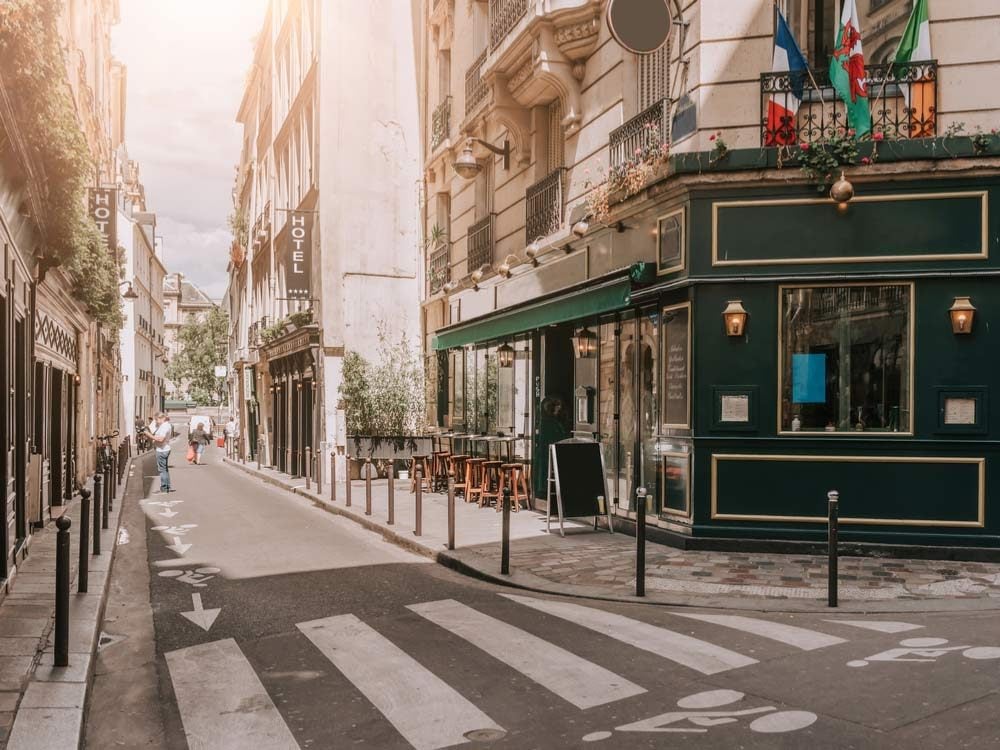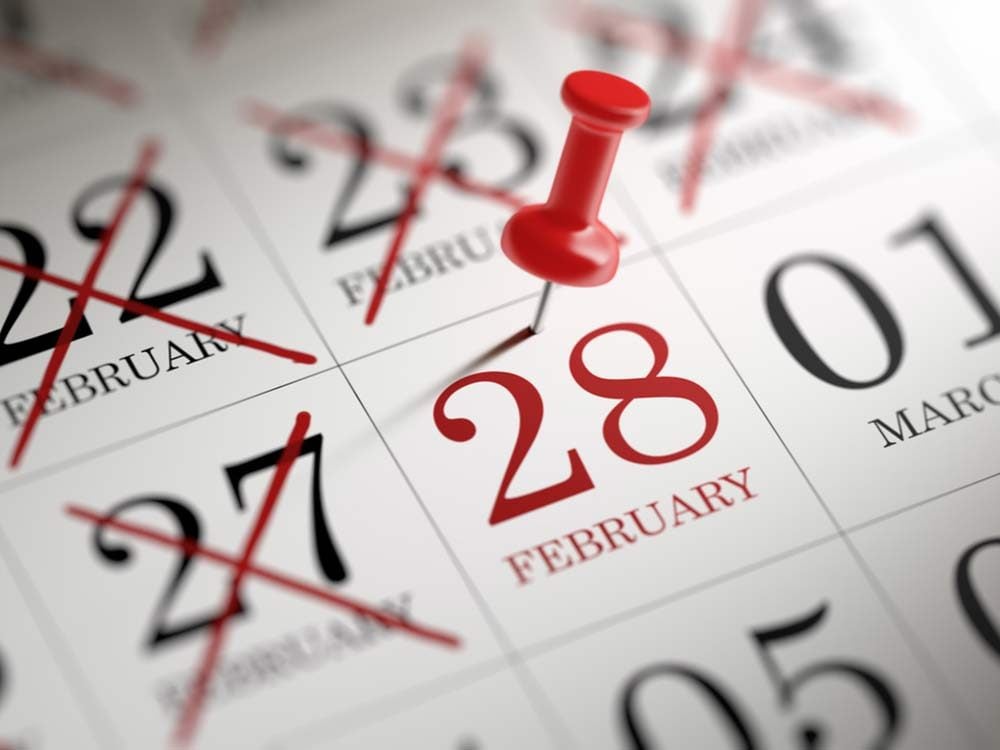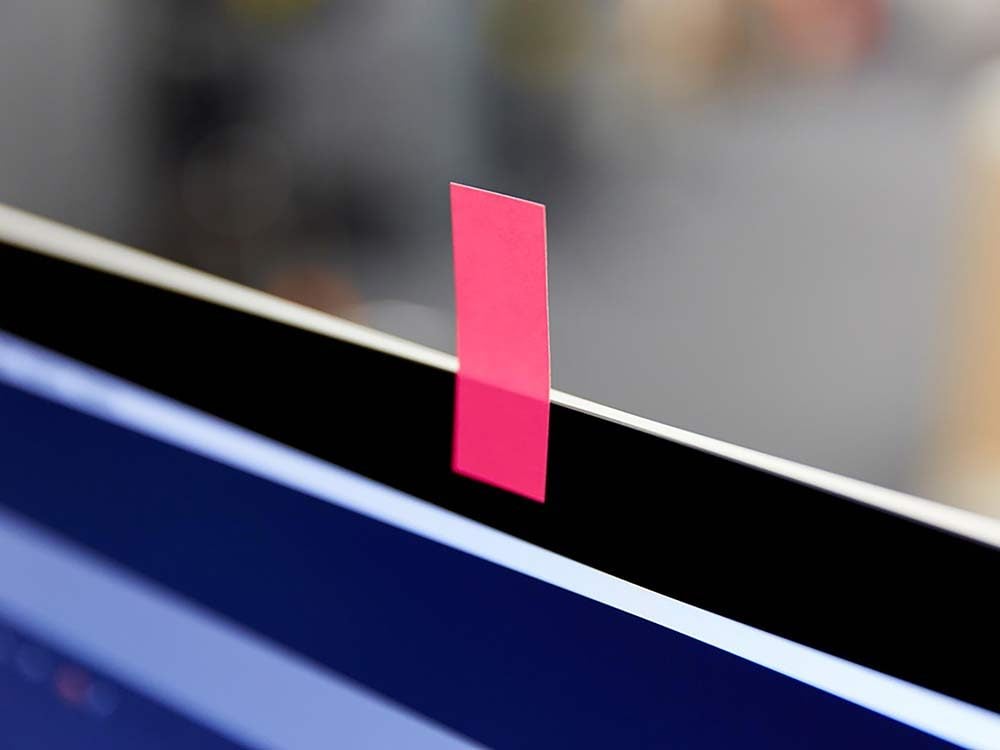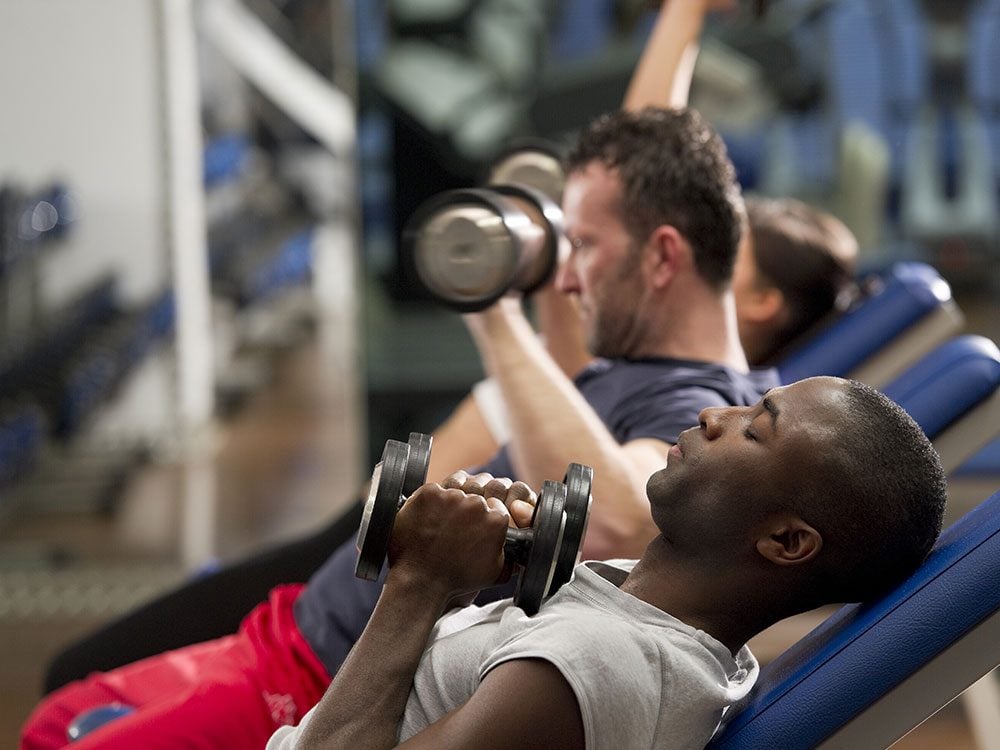
Why Isn’t There a Single Stop Sign in Paris?
Whether you’re close to home or far away, it’s always a little nerve-wracking to drive in a big city. Navigating the sea of cars, one-way streets, and traffic lights can be stressful even if you’re a seasoned city driver. You probably know this all too well if you live in Toronto or Montreal, but stressful city driving isn’t unique to those two cities—or Canada, for that matter.
Take Paris, France, for instance. The City of Lights is famous for its chaotic roads, including the Champs-Élysées, a massive thoroughfare with no median, and the “Étoile,” or “star,” an enormous traffic circle that connects no fewer than 12 separate roads. You’d think stop signs would be a necessity—and yet the city doesn’t have a single one.
In Paris, cars don’t come to a full stop at any intersection without a traffic light. Cars on the right have the right of way, at both regular intersections and in traffic circles. While there are plenty of traffic signs in the city of Paris, red octagons are not among them.
Paris hasn’t always been a stop-sign-free metropolis, though. According to a Paris police report, the city did have one stop sign at one point. Yes, just one—a single red octagon reading “STOP” stood at the exit of a construction facility. (In case you’re wondering why a French sign said “stop,” “stop” is “considered a valid French word, borrowed from English.”) Yes, the only stop sign in the city was basically at the exit of a glorified driveway.
It was situated on the Quai Saint-Exupéry, a riverside road in Paris’s 16th district, on the outskirts of the city. And despite this sign’s unique claim to fame, it seems that no one paid much attention to it—because it suddenly vanished. Sometime between May 2012 and September 2014, the stop sign disappeared right off the post that held it, and it hasn’t returned. Whether it was an authorized removal or the work of a thief, we can only guess.
Don’t believe us? Take a look at Google Earth. Next to the “No Left Turn” sign, you can still see the post where Paris’s one stop sign once stood.
There may not be stop signs, but plenty of other signs keep the Parisian streets from devolving into chaos. One of the most common is the red circle with the line through it, a “Do Not Enter” sign indicating a one-way street. There are plenty of “No Left Turn” signs as well, just like the one that stood next to the stop sign.
Basically, if you ever find yourself behind the wheel in Paris, make sure you’re driving very carefully—just like you would anywhere else.
Learn why Japan has blue traffic lights instead of green!
[Sources: thestar.com, planet.fr, thelocal.fr]

Why is the Contraction for Will Not “Won’t”?
Like many grammar rules in the English language, using “won’t” as the contraction for “will not” doesn’t make a lot of sense. If we formed it like most other contractions, the result would be “willn’t.” Admittedly, that is a bit more difficult to say than “willn’t,” but come on, English language. What’s the deal?
Blame our European ancestors. Centuries ago, the Ye Olde English verb willan (which meant to wish or will) had two forms: wil- for the present tense and wold- for the past tense. But as time went on, the pronunciation of these verbs kept changing, from “wool” to “wel” to “woll” to “ool.” (Here are 10 obsolete yet colourful words.)
By the 16th century, there was finally some consensus on the preferred versions of this pesky word. Wil- became the familiar “will,” and wold- became our “would.” But the most popular form of the negative verb became “woll not,” which was contracted to “wonnot,” which modern English turned into “won’t.” (Spell check won’t catch these nine spelling and grammar mistakes.)
So contracting “will not” the logical way may not be so logical after all.
Check out 20 Jokes Every Grammar Nerd Will Appreciate!

Fake yourself out
Literally turn that frown upside down: The act of smiling, even if you’re totally faking, can make you feel happier, psychologist Edward J. Cumella, PhD, told Reader’s Digest. Same goes for laughing, so watch a quick video of your favourite comedian or TV show, or the recorded antics of your pet or toddler. Or try these hilarious jokes. They are guaranteed to make you laugh so hard you cry, chasing away your moody blues.
Try color therapy
Wearing red can help you feel more confident, which might help you stare down that bad mood and send it packing. And even if Kermit says it’s not easy being green, colour psychologists tell us that wearing—or even just seeing!—a nice fresh green can evoke happiness. Need to feel more relaxed? Then try a blue hue.
Tune in to a tune
Music is a known mood-booster, so pop on an upbeat playlist of your favourites and cheer up quickly. Research has found that listening to music can reduce the pain and anxiety of surgery, so it should work when you just need a perk-up! It has a cumulative effect, too. If you want a longer-lasting mood boost, prescribe yourself at least one happy song a day.
Give yourself a mini-massage
A full-body massage from a professional therapist is ideal for stress relief. But when you need a quick fix, try this handy trick. Press your thumb into the outside corner of the palm of your opposite hand. Slowly massage, using a circular motion. Then move your thumb inward and repeat your circles. Continue inching inward until you reach the centre of your palm. (Check out these five other self-message techniques.)
Hug it out
Hugging one of your favourite people or animals can instantly lift your mood with a surge of “happy hormones,” serotonin and oxytocin. Grab whoever’s nearby and give them a good 20-second squeeze; you’ll both benefit! And here’s why touch might be the most important of our five senses.
Snack for happiness and health
You can also get serotonin, and a related amino acid, tryptophan, from food. So try a breakfast with eggs, turkey, chicken, or cheese, and add some nuts, banana, pineapple, or plums to pump up those brain chemicals. (Here are three ways to prevent depression.)
Be scents-itive
Research into the power of essential oils has pointed to orange and lavender scents as mood-boosters. Taking a whiff of either these aromas can help improve your mood and reduce any anxiety you might be feeling. You can diffuse the scent in your home or office, or just take a good sniff from a container of oil or another scented object.
Walk it off
Walk your way out of a lousy mood. A quick stroll—just five or 10 minutes—gives you three cheerer-uppers in one: Fresh air, sunlight, and movement—not to mention a bevy of health benefits. Exercise releases feel-good endorphins in your body, the sun gives you vitamin D, and outdoor air offers a nice hit of oxygen and encourages you to breathe it in deeply.
Just picture it
Outdoor walks are beneficial, and so are walks down memory lane! Research has found that scrolling through pics of your friends, family, and travels can boost your mood as well, or better, than listening to music, drinking a glass of wine, or even eating chocolate.
Do a good deed
Cheer yourself up by cheering someone else. The “helper halo” effect is real! Get inspired and find someone who could use your help today. Offer a cup of coffee, a sweet note, or even just a smile. It’ll do you both good.
Pray or meditate
Whatever your spiritual practice, spending a few minutes on it can elevate your mood. Being mindful can change your brain and improve your well-being. And some time in prayer or meditation helps distract you from whatever it is that’s dragging you down today. See the bigger picture. Try these little ways to sneak more meditation into your day.
Find some flowers
Pick up an inexpensive bouquet for your desk, or just take notice of the flowers outside your window or along your route to work. Getting a glimpse of floral beauty can reduce anxiety and even improve productivity and creativity, whether you are male or female, young or old.
Claim victory
Give yourself a little win to counteract the grumps. What’s your party trick? If you can balance a spoon on your nose, play a quick tune on the piano, or magically pull a quarter from your kid’s ear, do it now—just for the satisfaction of knowing you can.
Stretch and soothe
Yoga poses like these easy ones can reverse a bad mood quicker than you can say “downward-facing dog.” The best postures for changing your mindset include inversions, backbends, and balances. Start and finish with a child’s pose for relaxation. In between, try:
- Inversions (where your head is below your heart) for a literal change of perspective and a lowering of blood pressure: Headstand, shoulder stand, legs up the wall, and down dog
- Backbends for energy and increased blood flow: bow, wheel, dancer, and camel
- Balance poses to shift your focus away from your mood to maintaining your balance: tree, eagle, boat

Would you be able to handle the world’s longest airplane flight?
Some people enjoy air travel more than others, but it’s safe to say that no one looks forward to extra-long flights. Even if you follow these 14 things you should never do on an airplane, a person can only tolerate so much time in a cramped cabin 10,000 metres above the ground.
For passengers flying from Doha, the capital of Qatar located off the Persian Gulf, to Auckland, New Zealand, that travel time couldn’t be any longer. The Qatar Airways flight from Doha to Auckland lasts 16 hours and 10 minutes heading toward New Zealand—and an anxiety-inducing 17 hours and 30 minutes on the return to Qatar, making it the longest flight in the world. (Here’s why airlines don’t tell you how long flights really are.)
The 14,535 kilometre route crosses more than 10 time zones. On the inaugural flight in February 2017, the plane left Sunday morning Doha time and arrived early Monday morning New Zealand time. However, Singapore Airlines may soon usurp the title of “World’s Longest Flight;” it has plans to resume direct flights from Singapore to New York, which would travel more than 15,280 kilometres.
If you happen to embark on this flight, or any flight that puts your stomach in knots, you’re going to want to memorize the one word you need to say to get your flight attendant to like you. And prepare for the worst jetlag of your life.
[Source: USA TODAY]
Here are 21 Secrets Your Flight Attendant Won’t Tell You!

Why Are There Only 28 Days in February?
February is a terrible month. By the time it arrives, we’re sick of the cold, sick of our winter clothes, and in many cases, just plain old sick. Fortunately, it’s a short month—just 28 days. But why? (Check out the surprisingly dark history of Valentine’s Day.)
Turns out, it’s not because everyone in the history of the human race has hated February. The month’s quirky timing dates back to the 10-month Roman calendar, which began in March and ended in December. That’s right. For a while, January and February didn’t even exist. To the Romans, who made their lot by planting and harvesting, winter was a nameless, dateless slog. For part of the year, there was literally no system for keeping track of the days. (Discover the history behind these common superstitions.)
By the time the second king of Rome took the throne around 750 BC, the Romans decided to add two more months to their year in order to sync their calendar more accurately with the 12 lunar cycles. Those two months—January and February—had 28 days each, until the king decided to add an extra day to January to make the year 355 days long. Even numbers were considered unlucky at the time, and a 354-day year was unacceptable. (Here are 22 history lessons your teacher lied to you about.)
The calendar still had its flaws. Following the lunar cycle worked well for a few years, but soon the seasons became out of sync with their typical months. To fix it, the Romans added a leap month called Mercedonius. Rome’s high priests would decide when the month would arrive, and no one else in the city could keep track of what day it was. As you might have guessed, this was a nightmare.
When Julius Caesar took power, he reconfigured the entire thing again and aligned the length of the year with the sun, so that each year would add up to 365 days. For some reason, he left February at 28 days.
And you know what? We totally agree with that arbitrary decision. February should always be as short as possible; no one likes it that much anyway.
Check out the 10 Luckiest Wedding Traditions from Around the World!

Here’s What’s Banned from Disney Movies
You’d think anything goes when it comes to Disney. The classic children’s movies contain traumatizing scenes like Scar’s pack of hyenas planning a murder in The Lion King or the hunter getting ready to stab Snow White. Other moments just seem questionable for kids, like the caterpillar smoking something questionable in Alice in Wonderland and Dumbo’s trippy night of drinking. These days, though, the Walt Disney Company spells out specific things its characters can’t do.
David Lowery, director of the 2016 Pete’s Dragon, made the big reveal in an interview with Ain’t It Cool News. “When you sign a contract with Disney, the thing it says your film cannot have are beheadings, impalement, or smoking,” he revealed. Lowery didn’t have any intel on whether the rule holds true for adult movies, but the last rule started in 2015, when Walt Disney Company chairman and CEO Bob Iger banned smoking in any Disney film. The only exceptions are R-rated movies and any scenes in which smoking is necessary to maintain historical accuracy. (Here are 13 tips for surviving a Disney cruise with your kids.)
Guess a few scenes from the Disney vaults wouldn’t fly if they were made today. After all, Pinocchio tries his hand at a cigar—and gets sick and loopy after breaking the current no-smoking rule. Smoking also appears in 101 Dalmatians, Peter Pan, Hercules, Aladdin, and a laundry list of others. (These 12 children’s book encourage kids to be nice.)
Plus, Eric steers a ship toward Ursula in The Little Mermaid, driving the stern through her belly as she’s struck by lightning and drags the boat down with her. Yikes. There goes the impaling rule.
Disney seems to have stuck by its no-beheading policy throughout its whole history, though. The Queen of Hearts may have hinted at it, but she never actually succeeded in having “off with their heads”—at least not on screen.
Check out the most popular movies from each year—from 1933 to now!

Remember what your mom told you about swallowing chewing gum?
The human body can do some incredible things, but unfortunately, sometimes its abilities are undermined. A perfect example of this is the age-old myth that if you swallow chewing gum it’ll stay in your body for seven years. “This is about as scientifically true as swallowing watermelon seeds will make you grow a watermelon in your stomach,” says Caleb Backe, health and wellness expert for Maple Holistics.
While it’s not true that chewing gum will stay in your body for seven years, it is true that the synthetic portion of it isn’t digestible. But that doesn’t mean that the synthetic portions are just going to sit around for years—gum rarely stays in your body for more than a week. This is because the stomach periodically empties its contents into the small intestine, so if you swallowed gum it would then move to the colon, and finally pass in the stool, according to u.osu.edu. (Check out these surprising things your farts can reveal about your health.)
With that being said, “Some components of gum, such as sweeteners, are actually digested,” writes Fabian Ortega for yalescientific.org. However, frequently swallowing wads of chewing gum won’t do your body any favours.
“Repeatedly swallowing gum can lead to a bezoar, a small mass of indigestible material that can potentially lead to a bowel obstruction,” says Edwin McDonald, a gastroenterologist at the University of Chicago and Associate Director of Adult Nutrition.
So can you occasionally swallow chewing gum and be OK? Yes. Should you? Probably not. “It would be wise to avoid making this a habit,” Ortega writes for yalescientific.org. “In order to avoid a potentially sticky situation, it is good practice to spit out your chewing gum.”
Now that you know what really happens after you swallow chewing gum, here are some other myths about food that have officially been busted.
Strange but true: Check out these 9 Surprising Health Benefits of Chewing Gum!

Should You Cover Your Laptop Camera?
In our tech-driven world, it’s now obvious that our privacy can be easily compromised. If hackers can penetrate the White House, they can likely crack our personal devices. And yet we still use our phones, laptops, tablets, and more, as if that threat doesn’t exist. But can we really afford to ignore it? (Here are five ways to prevent identity theft at the office.)
If you have a modern device capable of getting online, chances are that it has a camera. And if so, there’s a probability that someone is looking for money or a glance at your intimate moments. Such driving factors have made way for a thriving black market for compromised webcams and the videos or photos they can produce. That’s why you may have heard the suggestion to protect yourself by taping over your computer camera and other devices with cameras. (Avoid posting these seven photos on social media.)
The tip is not based simply on paranoia. In 2014, the FBI ran its largest cyber operation to date, in which scores of webcam hackers in more than 12 countries were arrested. The program, called Blackshades, gave users access to “photographs and other files on the victim’s computer and a record all of the keystrokes entered on the victim’s keyboard,” according to a report. It allowed them to steal passwords to the victims’ online accounts, and even activate the victim’s web camera to spy on them, all in secret.
And that’s just one vindictive tool that hackers have used on computers around the world. Apparently, there’s some evidence to suggest that the FBI has also hacked into people’s computers in order to access their webcams for surveillance.
Many Internet-connected webcams have their own IP address to permit remote access, which lets you connect directly to the webcam from anywhere in the world. However, if your camera is not protected by a strong password (which many of them aren’t), it makes it all that much easier for hackers to infiltrate.
As for computer-connected webcams, hackers can use malware to access the cameras. This can happen when you accidentally click a bad link or download a sinister file.
“I’m quite confident that my own computer is not infected by malware—yet,” says Mikko Hermanni Hyppönen, a computer security expert and columnist who has assisted law enforcement in the United States, Europe, and Asia since the 1990s on cybercrime cases. “I cover my camera just in case, and to set an example. It’s not a bad idea.”
Chief Research Officer at F-Secure, a cyber security and privacy company based in Helsinki, Finland, Hyppönen is known for taking down the Sobig Worm in August of 2003, a computer worm that infected millions of Internet-connected, Microsoft Windows computers.
“There are plenty of trojans out there that can spy on you via your computer’s camera. We’ve even seen criminals ask money from people after they have collected embarrassing pictures of them via webcam,” he says.
It seems safe to say that, if you don’t want people watching your every move—especially without your permission and when you don’t know it—the only way to protect yourself in terms of your technology is to cover up the camera when not in use. And frankly, it really can’t hurt. It’s just a piece of tape.
Discover why the letters on a computer keyboard aren’t in alphabetical order.

This One Mistake Can Ruin Your Workout
You probably suspect that there are plenty of secrets personal trainers won’t tell you for free. But when it comes to getting the maximum gains for your pain, here’s one complimentary tip from a certified PT: You might want to rethink the order of your workout. (These insider tips will help you get the most out of your gym membership.)
Most people head straight to the cardio machines before lifting a single dumbbell. While a bit of cardio gets your heart pumping and your muscles working, regularly hitting the treadmills first could backfire in the long run. That’s why personal trainer Max Lowery recommends starting your workout with weight training. (This is the best exercise to flatten your belly.)
“It’s a huge mistake doing your cardio and exhausting yourself before you do weights,” Lowery told the Independent. “If you want the weight session to be 100 per cent effective, you need to be fresh.”
According to Lowery, a hardcore cardio session can deplete your muscles’ stores of “explosive” energy, leaving you exhausted by the time you hit the weight room. As a result, your strength and weight training won’t be nearly as effective. Wearing yourself out before your weight session could also make you more vulnerable to injury, Lowery says. Plus, lifting weights one of the best calorie-busting exercises you can do. What do you have to lose?
But hitting the weights with tight, cold muscles won’t help you tone up, either. To avoid injury (and boost your gains!), you still need to properly prep your body. “Warming up your body gets blood flowing to help lubricate your joints, which can help prevent you from tearing something,” William Suggs, a certified personal trainer and licensed sports nutritionist in New York City, told Reader’s Digest. He recommends starting off with a brisk 10-minute walk or a light stretch.
Bottom line: To get real results from your workout routine, head for the weight rack ASAP.
Professional wrestler Robbie E reveals the secret to staying fit after fatherhood.

Ever wonder why our milk is sold in bags?
If you’ve ever travelled to the U.S. (or virtually anywhere outside of Canada for that matter), you may have noticed something peculiar about how milk is sold in grocery stores. You’ll find milk in a carton or jug—but you certainly won’t find it in that familiar nine-pound clear plastic bag. But why? We need answers!
According to foodnetwork.ca, drinking milk out of bags isn’t new—in fact, Canadians have been doing this since the late 1960s. Before Canadian food and packaging company DuPont unveiled their thin, plastic milk bags in 1967, they used glass bottles instead. Ultimately, all of those glass bottles weren’t exactly cost-efficient—and, with Canada’s conversion to the metric system in 1970, it was far easier to comply with metric units in bag form that it was to redesign and manufacture new bottles and jugs. So, the plastic milk bag was born. Today, drinking milk out of a bag is most popular in Quebec, Ontario, and the Maritimes. (By the way, this is why we refrigerate our eggs and Europeans don’t.)
“It’s estimated that 75 to 80 per cent of the milk sold in Ontario is bagged, and across Canada, about 50 per cent of milk drinkers buy the bagged variety,” according to foodnetwork.ca. Surprisingly, Canada isn’t the only place where people drink their milk out of bags. “Milk bags can be found in many other countries, such as South Africa, Argentina, Uruguay, Hungary, and China. In Israel, there’s a Kankomat: soft, plastic milk bags with a knife built into a plastic container.”
So, there you have it. In Canada, we drink our milk out of plastic bags because it’s more cost-effective.
[Sources: Mental Floss, Food Network, Modern Farmer]
Check out the 10 Things You Should Never Say to a Canadian!